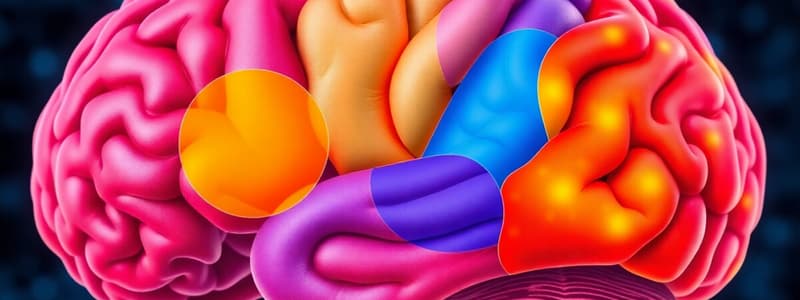Podcast
Questions and Answers
The major output pathway for hippocampal communication related to memory is the ______.
The major output pathway for hippocampal communication related to memory is the ______.
fornix
The ______ is involved in emotional value assessment and reward processing.
The ______ is involved in emotional value assessment and reward processing.
orbitofrontal cortex
The ______ acts as a sensory relay, aiding attention and memory processes.
The ______ acts as a sensory relay, aiding attention and memory processes.
thalamus
Damage to ______ area results in difficulties with speech production, leading to Broca's aphasia.
Damage to ______ area results in difficulties with speech production, leading to Broca's aphasia.
Signup and view all the answers
The ______ is crucial for converting short-term memories into long-term formations.
The ______ is crucial for converting short-term memories into long-term formations.
Signup and view all the answers
The ______ cortex is engaged in working memory and attention maintenance.
The ______ cortex is engaged in working memory and attention maintenance.
Signup and view all the answers
The integration of sensory input with motor commands is a function of the ______ cortex.
The integration of sensory input with motor commands is a function of the ______ cortex.
Signup and view all the answers
Regulation of emotional responses and decision-making is primarily associated with the ______ prefrontal cortex.
Regulation of emotional responses and decision-making is primarily associated with the ______ prefrontal cortex.
Signup and view all the answers
Target detection and cognitive processes like attention reorienting are vital functions of the ______.
Target detection and cognitive processes like attention reorienting are vital functions of the ______.
Signup and view all the answers
The ______ cortex is central to executive functions such as reasoning and planning.
The ______ cortex is central to executive functions such as reasoning and planning.
Signup and view all the answers
Memory processing and internally directed thought, like daydreaming, involve the ______ cingulate cortex.
Memory processing and internally directed thought, like daydreaming, involve the ______ cingulate cortex.
Signup and view all the answers
Forming new memories is primarily the function of the ______.
Forming new memories is primarily the function of the ______.
Signup and view all the answers
The ______ influences memory strength by processing emotions.
The ______ influences memory strength by processing emotions.
Signup and view all the answers
Study Notes
Attention
- Superior Frontal Cortex: Plays a crucial role in maintaining focus, holding information in mind (working memory), and controlling intentional movements.
- Posterior Parietal Cortex: Integrates sensory information to guide our actions. It's essential for spatial understanding, allowing us to be aware of our surroundings and attend to specific objects within them.
- Ventral Prefrontal Cortex: Handles our assessment of risk and fear, impacting our decisions based on potential emotional consequences. It also plays a role in regulating emotional responses to incoming stimuli.
- Temporoparietal Junction (TPJ): Helps us detect important stimuli in our environment and shift our attention accordingly. It also contributes to understanding others' perspectives.
- Pulvinar of Thalamus: Active when we make quick eye movements (saccades). It filters sensory information to enhance visual attention, prioritizing relevant stimuli.
- Superior Colliculus: Drives eye movements towards new or interesting stimuli, helping us pay attention to what's changing in our visual world.
Cognitive Control
- Lateral Prefrontal Cortex: The central hub of our executive functions, responsible for reasoning, planning for the future, and making decisions.
- Frontal Pole: Manages complex tasks that require planning and strategy, particularly when we're juggling multiple things at once.
- Orbitofrontal Cortex: Processes both rewards and punishments, influencing our decisions and ability to control impulses.
- Medial Frontal Cortex: Involved in decision-making, anticipating rewards, evaluating ourselves, and noticing when we make errors.
- Primary Motor Cortex: Initiates voluntary movements, essential for planning and carrying out actions.
- Secondary Motor Areas: Help us execute complex movements needing multiple steps, often working in coordination with the premotor cortex.
Social Cognition
- Ventral Medial Prefrontal Cortex: Processes emotional responses and assesses social risks, influencing our behavior in social situations.
- Anterior Cingulate Cortex: Vital for emotional regulation, controlling impulses, making decisions, and understanding the feelings of others.
- Posterior Cingulate Cortex: Plays a role in memory processing and internally directed thinking, like daydreaming.
- Medial Parietal Cortex (Precuneus): Connected to awareness of ourselves and our place in the social world.
- Dorsolateral Prefrontal Cortex: Supports working memory and cognitive flexibility, allowing us to adapt our thinking in social contexts.
- Ventral and Ventrolateral Prefrontal Cortex: Process uncertain risks and influences decision-making in emotionally charged situations.
Memory
- Hippocampus: Forms new memories, linking them to emotions and learning.
- Amygdala: Impacts how strongly we remember things based on their emotional significance.
- Fornix: Key communication pathway from the hippocampus, transferring memory-related information.
- Anterior Thalamic Nucleus: Acts as a memory relay center to the cortex, crucial for alertness and memory.
- Mammillary Body: Part of the limbic system, contributing to recognizing familiar things and events.
- Medial Temporal Lobe: Essential for converting short-term memories into long-term memories, housing the hippocampus.
- Perirhinal Cortex & Entorhinal Cortex: Crucial for recognizing objects and forming memories, connecting the hippocampus to the neocortex.
- Parahippocampal Cortex: Helps us encode and retrieve memories, especially ones linked to spatial awareness.
Emotion
- Orbitofrontal Cortex: Assesses the emotional value of stimuli and processes rewards.
- Cingulate Gyrus: Manages emotions and bodily functions like heart rate and breathing, part of the limbic system.
- Thalamus: Relays sensory information, contributing to attention, alertness, and memory processing.
- Hypothalamus: Regulates emotional behavior and physiological responses to emotions.
- Amygdala: Crucial for developing emotions like fear and storing memories based on their emotional impact.
- Corpus Callosum: Connects the two brain hemispheres, allowing them to communicate effectively.
Language
- Broca's Area: Essential for producing speech. Damage here leads to Broca's aphasia - difficulty speaking fluently, but comprehension remains intact.
- Wernicke's Area: Critical for understanding language. Damage leads to Wernicke's aphasia - speech is often nonsensical, despite intact vocalization.
- Inferior Frontal Cortex: Involved in language production and complex reasoning, encompassing Broca's area.
- Superior Temporal Gyrus: Processes auditory information, key for language comprehension.
- Angular Gyrus: Plays a role in complex language functions like reading and writing.
- Supramarginal Gyrus: Important for processing the sounds of language and understanding their meaning.
- Sylvian Fissure: Separates the temporal lobe from the frontal and parietal lobes, a significant anatomical landmark.
Studying That Suits You
Use AI to generate personalized quizzes and flashcards to suit your learning preferences.
Description
Explore the intricate networks in the brain that regulate attention and focus. This quiz covers key areas such as the Superior Frontal Cortex and the Temporoparietal Junction. Test your understanding of how these regions integrate sensory information and influence decision-making.




